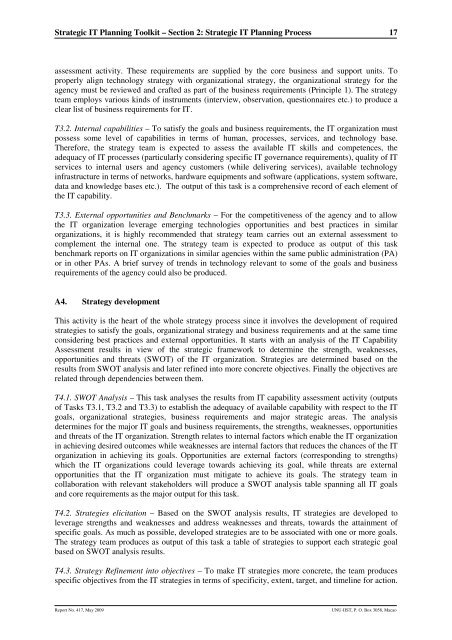Strategic IT Planning for Public Organizations: A Toolkit - UNU-IIST ...
Strategic IT Planning for Public Organizations: A Toolkit - UNU-IIST ...
Strategic IT Planning for Public Organizations: A Toolkit - UNU-IIST ...
You also want an ePaper? Increase the reach of your titles
YUMPU automatically turns print PDFs into web optimized ePapers that Google loves.
<strong>Strategic</strong> <strong>IT</strong> <strong>Planning</strong> <strong>Toolkit</strong> – Section 2: <strong>Strategic</strong> <strong>IT</strong> <strong>Planning</strong> Process<br />
17<br />
assessment activity. These requirements are supplied by the core business and support units. To<br />
properly align technology strategy with organizational strategy, the organizational strategy <strong>for</strong> the<br />
agency must be reviewed and crafted as part of the business requirements (Principle 1). The strategy<br />
team employs various kinds of instruments (interview, observation, questionnaires etc.) to produce a<br />
clear list of business requirements <strong>for</strong> <strong>IT</strong>.<br />
T3.2. Internal capabilities – To satisfy the goals and business requirements, the <strong>IT</strong> organization must<br />
possess some level of capabilities in terms of human, processes, services, and technology base.<br />
There<strong>for</strong>e, the strategy team is expected to assess the available <strong>IT</strong> skills and competences, the<br />
adequacy of <strong>IT</strong> processes (particularly considering specific <strong>IT</strong> governance requirements), quality of <strong>IT</strong><br />
services to internal users and agency customers (while delivering services), available technology<br />
infrastructure in terms of networks, hardware equipments and software (applications, system software,<br />
data and knowledge bases etc.). The output of this task is a comprehensive record of each element of<br />
the <strong>IT</strong> capability.<br />
T3.3. External opportunities and Benchmarks – For the competitiveness of the agency and to allow<br />
the <strong>IT</strong> organization leverage emerging technologies opportunities and best practices in similar<br />
organizations, it is highly recommended that strategy team carries out an external assessment to<br />
complement the internal one. The strategy team is expected to produce as output of this task<br />
benchmark reports on <strong>IT</strong> organizations in similar agencies within the same public administration (PA)<br />
or in other PAs. A brief survey of trends in technology relevant to some of the goals and business<br />
requirements of the agency could also be produced.<br />
A4. Strategy development<br />
This activity is the heart of the whole strategy process since it involves the development of required<br />
strategies to satisfy the goals, organizational strategy and business requirements and at the same time<br />
considering best practices and external opportunities. It starts with an analysis of the <strong>IT</strong> Capability<br />
Assessment results in view of the strategic framework to determine the strength, weaknesses,<br />
opportunities and threats (SWOT) of the <strong>IT</strong> organization. Strategies are determined based on the<br />
results from SWOT analysis and later refined into more concrete objectives. Finally the objectives are<br />
related through dependencies between them.<br />
T4.1. SWOT Analysis – This task analyses the results from <strong>IT</strong> capability assessment activity (outputs<br />
of Tasks T3.1, T3.2 and T3.3) to establish the adequacy of available capability with respect to the <strong>IT</strong><br />
goals, organizational strategies, business requirements and major strategic areas. The analysis<br />
determines <strong>for</strong> the major <strong>IT</strong> goals and business requirements, the strengths, weaknesses, opportunities<br />
and threats of the <strong>IT</strong> organization. Strength relates to internal factors which enable the <strong>IT</strong> organization<br />
in achieving desired outcomes while weaknesses are internal factors that reduces the chances of the <strong>IT</strong><br />
organization in achieving its goals. Opportunities are external factors (corresponding to strengths)<br />
which the <strong>IT</strong> organizations could leverage towards achieving its goal, while threats are external<br />
opportunities that the <strong>IT</strong> organization must mitigate to achieve its goals. The strategy team in<br />
collaboration with relevant stakeholders will produce a SWOT analysis table spanning all <strong>IT</strong> goals<br />
and core requirements as the major output <strong>for</strong> this task.<br />
T4.2. Strategies elicitation – Based on the SWOT analysis results, <strong>IT</strong> strategies are developed to<br />
leverage strengths and weaknesses and address weaknesses and threats, towards the attainment of<br />
specific goals. As much as possible, developed strategies are to be associated with one or more goals.<br />
The strategy team produces as output of this task a table of strategies to support each strategic goal<br />
based on SWOT analysis results.<br />
T4.3. Strategy Refinement into objectives – To make <strong>IT</strong> strategies more concrete, the team produces<br />
specific objectives from the <strong>IT</strong> strategies in terms of specificity, extent, target, and timeline <strong>for</strong> action.<br />
Report No. 417, May 2009<br />
<strong>UNU</strong>-<strong>IIST</strong>, P. O. Box 3058, Macao

















